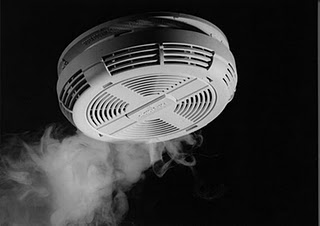
Photo: http://img.directindustry.com/images_di/photo-g/heat-and-smoke-detector-90581.jpg
One of the most important fire safety devices for the home is the smoke detector. Learning Where To Place A Smoke Alarm is important. “House Fires ~ Have A Plan!”
Several studies have concluded that when working smoke alarms are present, the chance of dying from the fire is cut in half. See my post
Many homes do not have the proper amount or properly located smoke detectors needed to protect the occupants properly. In this post, I will discuss how to protect your family with smoke alarms. One of the best ways to protect yourself is with a sprinkler system ~ See my post on “Residential Sprinkler Systems.”
Most smoke detector manufacturers recommend installing Smoke Alarms on the ceiling, or on the walls between 6 and 12 inches below the ceiling. The reason for this is these positions take advantage of the fact that most smoke rises.
All smoke detectors should be installed in accordance with the manufacturer’s recommendation and be UL listed. I also recommend hard wiring your smokes and using models with a battery back up.
Smoke alarms have a useful life of about ten years. At that age they should be replaced, even if they seem to be working
In Massachusetts the placement of smoke detectors in single family homes is governed by 780 CMR 3603.16.10 which provides guidance on the number of smoke detectors per household.
Effective April 5, 2010, a new regulation relating to the installation and maintenance of certain smoke detectors was put in place.
According to the new regulation, owners of certain residential buildings will be required to install and maintain both the ionization and photoelectric smoke detectors.
While the new regulation does not change the locations where smoke detectors are required, it does allow the installation of both technologies in certain locations.
Under the new regulation, an ionization detector can not be placed within 20 feet of a kitchen or a bathroom containing a shower or a tub. In these locations only a photo electronic detector is allowed.
All property owners should determine what type of smoke detectors they are currently have installed. In order to comply with the law you can either install two separate detectors that have both technologies or by installing one that utilizes both.
WHAT PROPERTIES ARE AFFECTED BY THE NEW REGULATION?
In order to determine if your property is affected by this change in the law it would be prudent to check with your local fire department.
If you are selling your home in Massachusetts one other law that you need to be aware of is what is known as Nicole’s Law. As of March 2006 when a home is transferred you need to have working carbon monoxide detectors.
Smoke detectors/heat detectors are required in the following locations:
1. In the immediate vicinity of the bedrooms
2. In all bedrooms
3. In each story of a dwelling unit, including basements and cellars, but not including crawl spaces and uninhabitable attics
4. In residential units of 1,200 square feet or more, automatic fire detectors, in the form of smoke detectors shall be provided for each 1,200 square feet of area or part thereof
5. Any smoke detector located within 20 feet of a kitchen or bathroom containing a tub or shower must be a photoelectric type .
The 1996 edition of NFPA 72 gives further guidance on the placement of smoke detectors, when required. Some examples from Chapter 2 of NFPA 72 are provided:
1. In unfinished construction, detectors should be mounted on the bottom of floor joists
2. Smoke detectors in a room with a ceiling sloped greater than one foot in eight feet horizontally, should be located on the high side of the ceiling
3. Smoke detectors should not be located within three (3) feet of a door to a bathroom containing a tub or a shower or the supply registers of a forced air HVAC system
4. Further guidance is provided by NFPA 72 for dead air spaces. Smoke detectors can be located on the ceiling with the side of the detector greater than four (4) inches from the wall or on the wall of a room with the top of the detector located four (4) to twelve (12) inches down from the ceiling.
5. Don’t put the alarm within six inches of where the wall and ceiling meet, on either surface. This area has proven to be a “dead air” space that receives little air circulation.
6. Also avoid areas where nominal amounts of smoke may normally be present, such as kitchens or other cooking spaces, furnace rooms or near fireplaces or wood burning stoves.
7. People selling their home need to have their smoke and carbon monoxide detectors inspected to the current standard. The requirements are based on when the house was built, provided the house has not had a substantial renovation. Read More.
Click here for a guide to smoke and carbon monoxide detectors in Massachusetts
